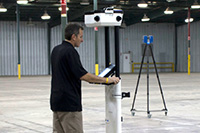1: Re-designing the spaces.
Before the pandemic, a big focus was on creating experiential environments. The mall of the future will be a different kind of gathering place. There is a reformulation of the size of tenants and a new look to stores. Landlords and tenants will need to collaborate.
2: Providing new access methods for consumers.
Digitally augmented techniques for contactless product exploration and purchase has been key to keeping many retailers alive. Once the purchase is complete, providing queuing isles, dedicated parking spots, and curbside pick-up are among the top trends as re-entry begins.
3: Meeting last-mile fulfillment needs for tenants.
Already a hot topic because of the relationship between physical and online stores, owners are looking to meet tenant logistics needs. Conceptually, it’s a win-win offer; retailers are already paying for last-mile “warehouse” space, and owners have “structurally vacant” space available. In recent days, Washington Prime announced they are offering fulfillment space to retailers at lower rates than their main stores.
4: Laying the groundwork for re-development.
From stores that offer consumers provisions and supplies to businesses that support the supply chain and logistics, attracting “essentials” businesses will be a primary focus in malls and shopping centers. Owners are taking more moderate and deliberate steps to ensure the success of these prospective new tenants; it’s a slow, calculated approach to meet the novel needs of a contemporary tenant.
5: Ramping up leasing capabilities.
Lease administration has slipped considerably over the past decade due to a continual churn of property ownership across retail real estate. Now, many are getting their documentation in shape, not only to improve their negotiation position, but also to understand how capacity can be reduced, relocated, or repurposed.






